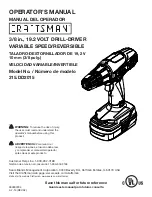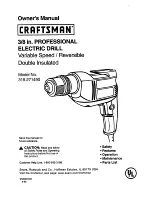
5
Change the Side burner orifices
(for models equipped with side burner)
1.
Manually remove side burner grates and burner caps.
2.
Use 10 mm socket and wrench or 10 mm nut driver to
remove the brass orifices from inside the burner base.
3.
Use 10 mm socket and wrench or 10 mm nut driver to install
the new 1.9 mm orifices supplied with this kit.
NOTE:
The number 1.9 is stamped on the orifice for
identification.
4.
Repeat the procedure for the other burner.
5.
Manually replace the burner top and caps.
6.
Manually replace the side burner grates.
Change the Sear burner orifices
(for models equipped with sear burner)
1.
Remove the sear burner cover screws. Set the screws and
cover aside.
2.
Remove the burner igniter mounting screws.
3.
Loosen the sear burner plate, located next to the igniter.
4.
Remove the sear burner mounting screws.
5.
Lift the sear burner out of the grill.
6.
Use 6 mm socket wrench or 6 mm nut driver to remove the
orifice. Install the new 2.34 mm orifice supplied.
NOTE:
The number 2.34 is stamped on the orifice for
identification.
7.
Reinstall sear burner. Make sure that the igniter is out of the
way to allow proper positioning of burner. Use Phillips
screwdriver to attach the mounting screws.
8.
Use Phillips screwdriver to reattach the igniter and sear
burner plate.
9.
Reinstall sear burner cover. Use Phillips screwdriver to attach
mounting screws.
For Connection to Natural gas and Leak Test
1.
Use pipe wrench to connect certified
¹⁄₂
" (1.3 cm) gas supply
pipe to inlet side of regulator from Natural gas supply
according to local codes requirements. Use pipe thread
sealant that is certified for use with Natural gas at
connections where required. There must be a certified
manual shutoff valve in the gas supply line near the grill for
easy access.
2.
Turn on the gas supply to the grill.
3.
Test all connections using an approved noncorrosive leak-
detection solution. Bubbles will show a leak. Correct any leak
found.
Check and Adjust the Burners
The burners are tested and factory-set for most efficient
operation. However, variations in gas supply and other conditions
may make minor adjustments to air shutter or low flame setting
necessary.
It is recommended that a qualified person make burner
adjustments.
NOTE:
The rotisserie burner cannot be adjusted.
Checking and adjusting the grill burner flames requires removing
the grate and sear plates.
Burner Flame Characteristics
The flames of the grill burners and side burners (on some models)
should be blue and stable with no excessive noise or lifting (LP
gas flames will have a slightly yellow tip). A yellow flame indicates
not enough air. If flame is noisy or lifts away from the burner, there
is too much air. Some yellow tips on flames when the burner is
set to HI setting are acceptable as long as no carbon or soot
deposits appear.
Check that burners are not blocked by dirt, debris, insect nests,
etc., and clean as necessary. If they are clean, adjust air shutters
as needed.
IMPORTANT:
Before adjusting air shutters, let burners cool
completely.
A. Sear burner cover screws
A. Burner igniter mounting screws
A. Sear burner mounting screws
A
A
A
A






























